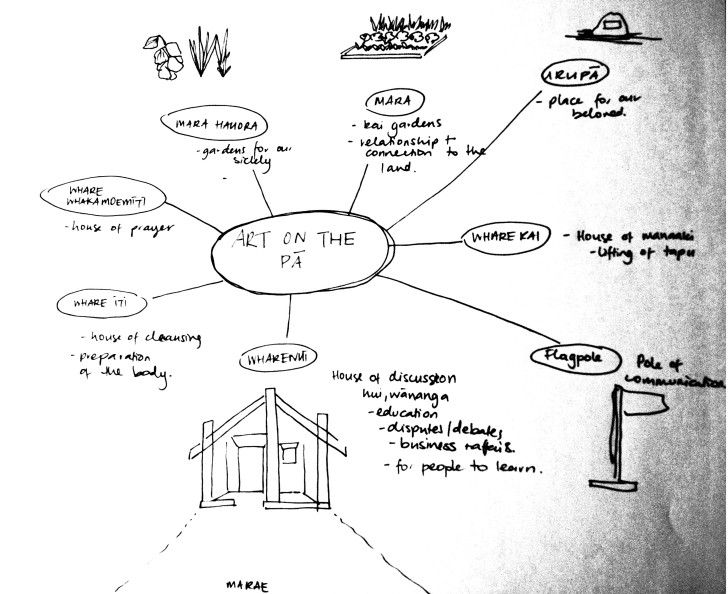Art on the Pā is in its organic stage of reactivating the Marae to what it once was. I hope to pick out offerings from my Curatorial Strategies classes within my Masters in Arts Management to work out curatorial practices and methodologies that include: Holistic approaches as to how we manage art and artists, looking at how we can reconnect the Marae or other indigenous spaces back its people and utilize traditional vessels of how we share and gain knowledge for everyone. The perception of Marae is that it is intimidating, therefor non-maori try avoid offending Maori in case they are seen as being culturally insensitive. This in return makes the culture less accessible and exclusive growing the gap between Maori and Non-Maori.
I am of Māori (Ngaati Te Ata Waiohua and Ngaati Tiipa) and Pāsifika (Tahitian, Samoan and Cook Island) descent and I see myself as caught in the middle of two worlds rich in cultural values and integrity but neither dominate my world as a young woman here in Auckland City. Despite my privileges as a young woman knowing where my Marae are, what waka my tupuna came on, what maunga and awa my people connect to as well as being confident in my stride on the city streets, my western thinking and behaviour consumes both sides of me. My language at one point was lost despite being brought up speaking Te Reo Māori. It has taken me almost ten years to reconnect with it. Now it is inappropriate to speak it out loud to audiences who do not understand when speaking and presenting as an artist to particular groups, I am seen as being ignorant.
My high schooling years had me in moments of peer pressure, that being in the bi-lingual units of three different high schools meant that I appeared to have entitled privileges of being excused from my mainstream classes every time there was a Māori hui where staff required a Māori girl to do the karanga, or help prepare the kai or lead the waiata tautoko for who ever spoke on our behalf. I chose to let go of my upbringing and knowledge passed down to me by my whanau in order to adjust to the modern world.
Since then, I have found relief in working as a Community Arts facilitator through mural arts and workshops in schools around South Auckland, majority being low-decile. After 5 years of practicing as a Mural artist and Facilitator, I found the relationships with people to be the real curatorial practice for me. I reflect and think how does this work fulfill my responsibility to my hapu and iwi or to my families in Rarotonga, Samoa and Tahiti?
What use does my work have within my own people?
A key focus on my practice is the ‘way’ I connect with people, especially young people. My interests reside in young people and where they want to be in 5 and 10 years time. It is critical to our society and our future here in Aotearoa to nurture this demographic. But how can I manage art and artists if I can’t manage the art of my own people?
This is the test, to take the last 5 years of my life back home to my marae. I have no immediate interests in curating an exhibition in a gallery in the middle of the city nor do I have an interest in managing art or artists involved with the Sydney Biennale. I am interested in strategically evolving from western practices back to what may have been the way my kuia grew up using holistic arts management that can return back to the people of the land. These annotated bibliographic texts will discuss perspectives that can weave the tuturu way of sharing knowledge and how the Marae can be a space for Maori to share their knowledge, tikanga and way of life with all.
Naku noa na
Amiria Puia-Taylor
